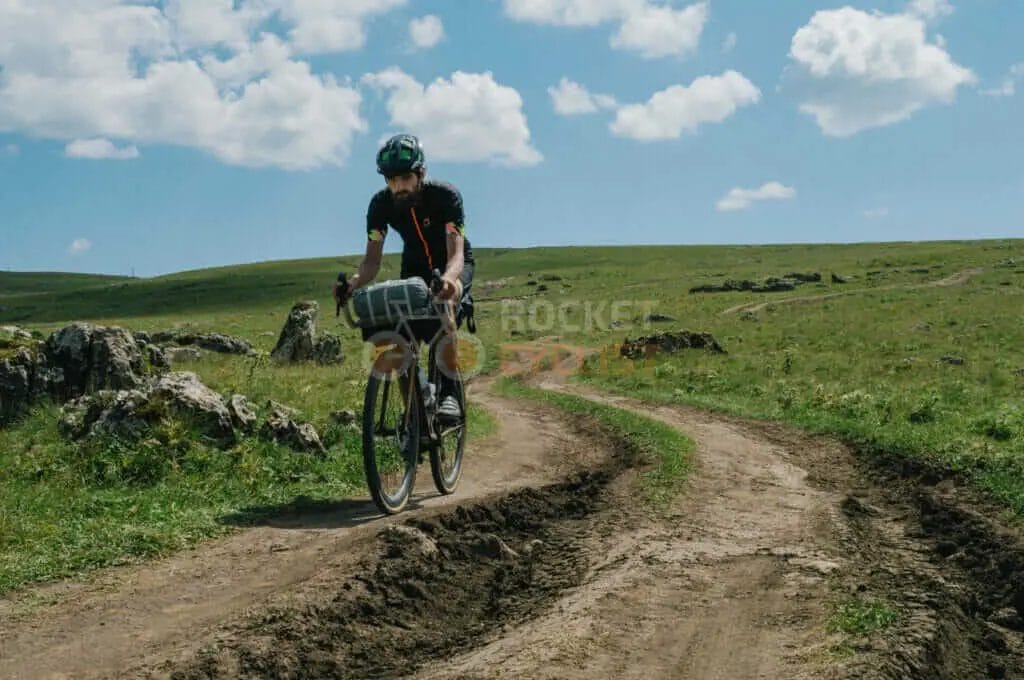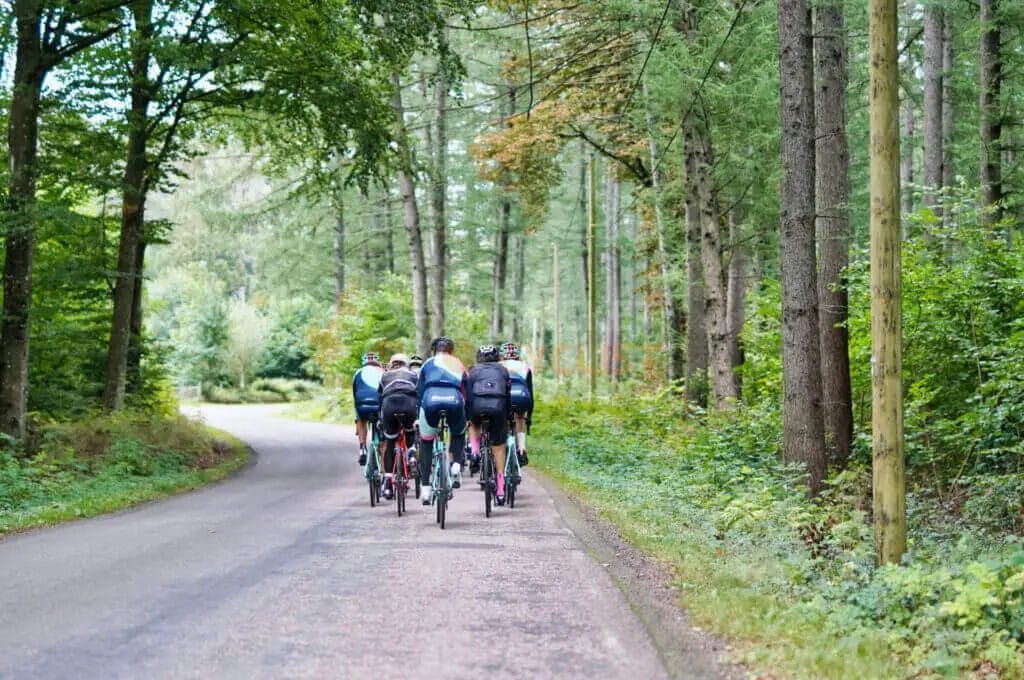Last Updated on March 1, 2024 by Vinson Lozano
Factors That Affect Riding Time

When planning a 60-mile bike ride, you might wonder, “How long does it take to cycle 60 miles?” There’s no one-size-fits-all answer to this question as several factors can affect the total time, including weather conditions, terrain difficulty, and the rider’s fitness level.
Weather Conditions
Weather conditions have a significant impact on your riding time. Riding in ideal conditions; calm, cool, and dry can result in faster times. However, harsh weather conditions such as high winds, extreme temperatures, or rain can slow you down, often considerably.
Terrain Difficulty

The difficulty of the terrain is another important factor to consider. Flat, smooth surfaces will allow for rapid and consistent cycling. In contrast, hilly or rough terrain can decrease your speed and require more time to traverse.
Fitness Level
Lastly, your personal fitness level substantially impacts your average speed and, consequently, the time it takes to cycle any distance. Highly fit cyclists can maintain an average speed between 20-25 miles per hour on flat ground, while less fit riders might maintain an average speed of 13-15 miles per hour.
So, to determine how long it takes to ride 60 miles, consider the weather, the terrain, and your fitness level to make an accurate estimate.
Average Riding Speeds
Getting a sense of average riding speeds based on the type of cycling can help calibrate expectations about how long a 60-mile ride might take.
Road Biking Speeds

On average, a cyclist on a road bike moves at about 15 to 20 miles per hour on flat terrain. However, factors such as the cyclist’s fitness level, the bike’s condition, and weather conditions can affect this average speed. So, at a moderate pace, it would take 3 to 4 hours to cover 60 miles.
- Average speed: 15-20 mph
- Time to ride 60 miles: 3-4 hrs
Mountain Biking Speeds
Mountain biking speeds, on the other hand, are generally slower due to the rugged and uneven terrain of mountain trails. A mountain biker typically rides at 6 to 14 miles per hour, depending on the trail’s difficulty. Therefore, a 60-mile mountain bike ride might take anywhere from 4.3 to 10 hours.
- Average speed: 6-14 mph
- Time to ride 60 miles: 4.3-10 hrs
Just remember, these are average estimates. Your cycling speed can largely be influenced by factors like the bike’s performance, your fitness level, and the actual route. Always consider these elements when planning a lengthy bike ride.
Road Biking Time
When participating in an outdoor activity like road biking, one significant factor to consider is the time it would take to cover certain distances. As per our topic, we will discuss on average, how long it could potentially take to ride 60 miles.
Calculating Riding Time on Roads
The duration it takes to ride 60 miles will greatly depend on the average biking speed. For example, if a cyclist can maintain an average speed of 15 mph, it would take 4 hours to complete the 60-mile distance. The following formula explains this:
Time (hours) = Distance (miles) ÷ Speed (mph)
Hence, riders with varying average speeds would experience different travel times, illustrated below:
- 10 mph average speed: 6 hours
- 15 mph average speed: 4 hours
- 20 mph average speed: 3 hours
Understanding these average speeds can help cyclists better plan their trips and manage their time more efficiently.
Tips for Increasing Riding Speed

Dedicated cyclists may aspire to diminish their travel time by increasing their average speed. Here are a few valuable tips for this purpose:
- Consistent Practice: The more you ride, the more your stamina and endurance improve. As such, you’ll be able to maintain a higher speed for longer.
- Strength Training: Specific exercises can support endurance and power for cycling.
- Good Nutrition: Eating a balanced diet and staying properly hydrated are essential for improved performance.
- Proper Gearing: Correct adjustments on your bike, such as gear shift, can make a notable difference in speed.
Through diligent effort and employing these strategies, it’s more than achievable to reduce your riding time dramatically.
Remember, your ultimate goal should be enjoying the ride and staying safe!
This answers the question, “How long does it take to ride 60 miles?”, and provides some helpful tips on enhancing your biking speed. Happy cycling!
Mountain Biking Time

The length of time it takes to ride 60 miles, particularly on a mountain bike, is influenced by a variety of factors. Here, we’ll calculate the average time it takes to ride this distance on trails, and also examine several factors that can impact this time.
Calculating Riding Time on Trails
Calculating the time to ride a certain distance depends heavily on the rider’s average speed. For instance, a mountain biker traveling at an average speed of 10 mph would theoretically take approximately six hours to cover 60 miles. However, this time may significantly vary depending on trail conditions, elevation gain, and the rider’s fitness level.
Factors Impacting Mountain Biking Time
Several key factors can impact the time it takes to ride 60 miles on a mountain bike:
- Trail Type: The type of trail plays a crucial role. For instance, a smooth, flat trail would obviously allow for a faster riding pace than a technical, uphill trail.
- Rider’s Fitness Level: A rider’s fitness level significantly influences their performance. An experienced and fit rider may be able to maintain a faster average speed over long distances.
- Weather Conditions: Adverse weather conditions, such as wind, rain, or extreme temperatures, can slow down a rider’s pace.
- Rest Breaks: The duration and frequency of rest breaks taken by the rider also play a significant part.
In general, it’s important to remember that these figures and factors provide an estimation, and actual riding times will always vary from rider to rider and day to day.
Training and Preparation

Embarking on a 60-mile ride, or essentially a metric century, requires ample training and preparation. Riders must build their endurance and be adequately equipped to ensure a smooth and safe journey.
Training for a 60-Mile Ride
Training for a 60-mile ride is critical to successfully complete the journey. Below are some key points to consider:
- Begin Early and Gradually – Start training several weeks or even months in advance. Begin with shorter rides and gradually increase your distance each week.
- Mix Up the Intensity – Incorporate high-intensity interval workouts into your training regimen to increase your cardiovascular fitness.
- Rest and Recovery – Allocating time for your body to rest and recuperate is as essential as the training itself.
Pre-Ride Preparation Checklist
Before embarking on your 60-mile ride, it’s necessary to crosscheck key items:
- Proper Nutrition and Hydration – Bring enough water and snacks, such as energy bars, for the ride.
- Equipment Check – Check your tire pressure, brakes, and ensure your bicycle is in optimal condition.
- Safety Gear – Always wear a helmet, and consider extra safety tools like lights, a bell, and reflective clothing if you’ll be riding on roads.
Overall, preparing for a 60-mile ride involves a mix of proper training combined with appropriate safety and nutrition preparation. This can go a long way in ensuring you have an enjoyable and safe journey.
Riding Time Estimation
Whether you’re a cycling enthusiast or a beginner venturing into long-distance biking, an essential factor to consider is: how long does the ride take? When it comes to riding 60 miles, many variables such as terrain, cyclist’s fitness level, and speed will impact the total ride time.
Estimating Riding Time Based on Terrain and Speed
Terrain and speed are certainly significant factors while predicting ride time. For instance, flat terrains can enable a higher average speed of about 15-20mph while hillier terrains might reduce your speed to 10-12mph. Consequently, if you ride at a steady 15 mph, you’ll be able to cover 60 miles in roughly 4 hours. However, with a speed of 10 mph, it may take up to 6 hours.
Planning Strategies for Long Rides
Cycling 60 miles is a challenge, and a few planning strategies can make your ride easier and more enjoyable:
- Ensure your bike is adequately configured to your comfort
- Plan your route carefully, considering the terrain and potential weather conditions
- Take regular breaks to hydrate and refuel
In conclusion, the time taken to ride 60 miles can significantly vary based on individual speeds and the terrain. For an enjoyable ride, careful planning and steady pacing are crucial. Happy riding!
Real-Life Examples
In understanding how long it takes to ride 60 miles, looking at the experiences of diverse cyclists can provide a more rounded perspective. Here, we share the stories of a few cyclists who have embarked on a 60-mile ride.
Stories and Experiences from Cyclists
John, a recreational cyclist: John usually rides his mountain bike at a leisurely pace of about 10 miles per hour. Thus, completing a 60-mile ride would typically take him around 6 hours, excluding any breaks.
Susan, a seasoned cyclist: As an expert cyclist, Susan often rides her road bike at a faster pace, around 20 miles per hour. Consequently, she typically completes a 60-mile ride in approximately 3 hours.
Lucy, a casual weekend cyclist: Lucy enjoys leisurely weekend bike rides and maintains a pace of about 15 miles per hour. Thus, it would take her about 4 hours to complete a 60-mile ride.
Here is a comparison of their experiences:
| Cyclist | Average Speed | Time Required for 60-mile ride |
|---|---|---|
| John | 10 mph | 6 hours |
| Susan | 20 mph | 3 hours |
| Lucy | 15 mph | 4 hours |
The time it takes to ride 60 miles depends on several factors, including the cyclist’s level of fitness, speed, cycling conditions, and breaks during the ride. If you’re planning a 60-mile cycling trek for the first time, remember to start training and gradually increase your endurance to make your ride enjoyable and safe.
Safety and Breaks
When planning to bike for 60 miles, considerations regarding safety and breaks should never be overlooked. Biking for long distances requires good preparation and strategies to ensure comfort and optimal performance are maintained throughout the journey.
Importance of Rest and Refueling
Rest is a paramount component in accomplishing a successful 60-mile bike ride. The body tends to get fatigued with long physical exertion and needs time for recovery. Commonly, cyclists take breaks after every 15 to 20 miles.
During these breaks, it is also essential to refuel the body. Intake of simple carbs and fluids can lead to improved stamina and endurance. Always remember to pack sufficient water and energy-rich snacks before the trip.
Tips for Staying Safe on Long Rides
Beyond the necessity for breaks and refueling, here are some other points for staying safe:
- Take note of the weather conditions: Before setting out for a long ride, always check the weather forecast to avoid any potential weather-related risks.
- Wear a helmet: A bicycle helmet reduces the risk of serious head and brain injuries by up to 88%.
- Use bike lights and reflective clothing: These ensure other road users can easily spot you, especially during dawn, twilight, or night-time.
Remember, the main goal is not only to complete the 60-mile ride but also to do so safely and comfortably.
Conclusion
In conclusion, the time it takes to ride 60 miles depends on several factors, including the cyclist’s speed, the terrain, and the weather conditions. Cycling speed can vary depending on the cyclist’s fitness level, bike type, and whether they’re cycling non-stop or taking breaks.
Summary of Factors Affecting Riding Time
- Speed: On average, a cyclist can ride between 10 to 20 miles per hour. At a moderate pace of 15 mph, it would take about 4 hours to ride 60 miles.
- Terrain: Cycling on flat terrain is faster than on hilly or mountainous terrain. The more uphill rides, the slower the pace.
- Weather Conditions: Weather greatly affects cycling speed. Headwinds slow you down while tailwinds can hasten your speed. Rain, snow, and extreme temperatures can also influence riding time.
Key Considerations for Riding 60 Miles
Here is a helpful list of considerations for those planning to take on a 60-mile bike ride:
- Plan the Route: Be aware of the distance, terrain, and any potential weather changes.
- Stay Hydrated: Carry enough water or sports drink, especially for long-distance cycling.
- Rest and Refuel: Plan breaks to rest and consume energy-boosting foods or gels.
- Ensure Bike is in Good Condition: Check the bike before setting off to avoid mechanical problems along the way.


